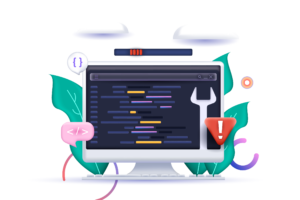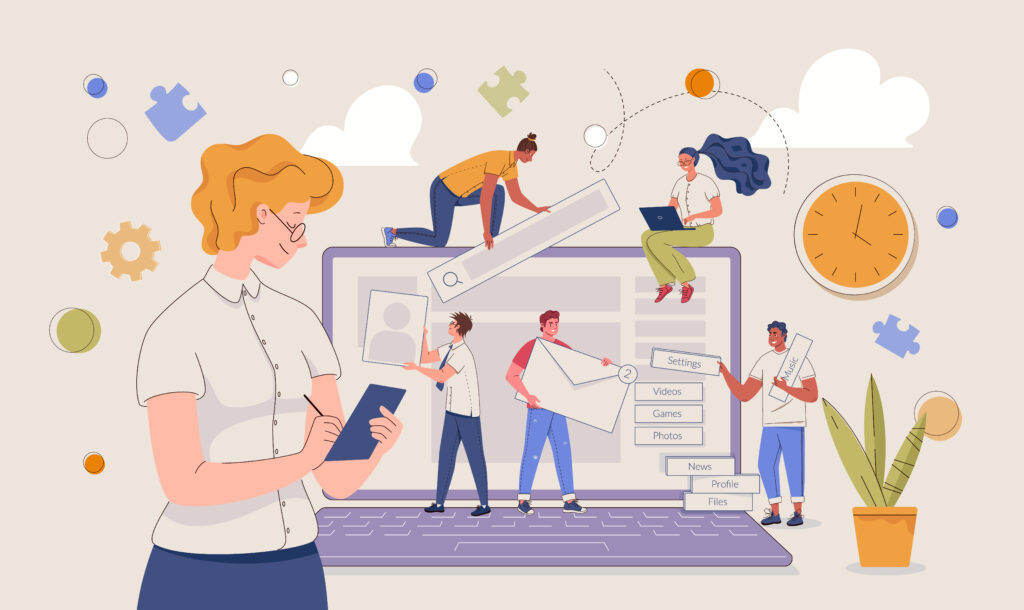A Software Development team plays a crucial role in bringing any software product to life. A software team structure comprises personnel from many professions, each with its responsibilities. Each stage of the software project, from design and development to final delivery, is dependent on the team. The outcome will always be the best when the software development team is more robust. In a software development team, a suitable hierarchy is maintained, which assists in establishing stronger connections with one another and, most importantly, roles and duties in a software development team are specified, ensuring that software projects progress smoothly.
As a result, an ideal software project necessitates forming an outstanding perfect software development team.
Are you considering launching a project but not sure how to organise your software development team? If you’re new to software development, you might not realise the importance of each team member’s involvement in custom software development. In this blog, we will assist you in understanding the roles and responsibilities of software development teams.
1. What Makes a Great Software Development Team?

When it comes to developing a high-performing software development team, team structure, talent, and communication are just a few of the most crucial things to consider. But how can you know it’ll be effective and yield results? This section will go over some helpful hints for assembling the ideal team.
1.1 Ensure that all roles and abilities are covered.
When you think of software development, you probably see programmers and engineers coding in various languages. However, if you want to develop an effective project team, you’ll need to do more. Business analysts, technological support, and people leaders are all required. Each role has its own set of responsibilities and abilities crucial for the project’s success. The team risks delays, poor quality, and unhappy customers without all parts covered.
1.2 Employ a diverse workforce.

It is now easier than ever to hire a diverse range of professionals in the age of working remotely and in virtual workspaces. You’ll help bring various concepts, perspectives, and values to your team if you look for talent from a variety of multiple backgrounds. Your diverse colleagues may be able to assist you in resolving problems that you have been unable to solve.
1.3 Objectives and KPIs should be communicated.

Each project member must know what is expected of them, just like any other member of an effective team. Specific, quantifiable, achievable, realistic, and timely goals should be set. Establishing team and individual KPIs is another good technique to get your team to perform at its best. Team members are more likely to own and accomplish goals and targets if they know them. Those who achieve or exceed their objectives should be praised and rewarded or exceed their objectives should be praised and rewarded or exceed their goals should be praised and rewarded too to maintain high levels of motivation.
1.4 Provide access to information.
You must ensure that your team members have all of the tools they require to access information for your project to go smoothly. Making data public ensures that your project’s progress is more transparent. It allows team members to see where they are making progress and where they may need to improve. This will assist you in streamlining your operations and completing your job more quickly and at a higher standard.
1.5 Automate your workflows.
Your team members will have more time to spend on commercial activities due to automation, which means they will be able to move faster through the project and the next. Programmers should focus on coding rather than invoicing. Analysts should be immersed in data rather than keeping track of their time. You should provide your employees with software that automates all of the time-consuming administrative procedures. This will also help to look after the well-being of your team members because you will be freeing up their time.
2. Overview of Roles and the Team Structure in Software Development Project

Depending on your technical partner, the number of individuals working on your software project may vary. Your project will almost certainly involve some or all of the software development roles listed below:
- Business analyst
- Project manager
- UX designer
- UI designer
- Developers
- Quality assurance specialist
- DevOps engineer
- Scrum Master
Let’s figure out who’s in charge of what.
2.1 Business Analyst

Some people believe that the sole purpose of business analysts is to make money for the corporation. However, this isn’t always the case in today’s commercial world. A well-trained BA can help a company achieve more production, efficiency, and profitability. BAs assist companies in analysing their current processes, defining actions and activities to enhance them designing new features, products or services, and evaluating late the impact of new implementations.
BAs work as a link between a business model and the product being built in the software development world. They examine company needs and transform them into development tasks that are easy to comprehend.
If you have a project idea or a business challenge to address but don’t have structured specifications and product criteria, we recommend hiring a BA.
2.1.1 What are the responsibilities of a business analyst?
- analyseRecognise market possibilities
- Discover, analyse, and report on user trends
- Identify potential adoption issues and propose solutions.
- Collaborate closely with designers to create a fantastic product experience.
- Assist clients in developing a clear product vision.
- Gathering, planning, documenting, and prioritising functional and technical requirements
- If necessary, test the product and prepare documentation and user manuals.
2.2 Project Manager

When all stakeholders are involved in the project, your likelihood of succeeding is substantially higher. Throughout the development process, a tremendous amount of information is exchanged. As a result, clear, timely, and effective team communication is critical. If there is poor communication, even a team of excellent engineers may not achieve the desired results. A project manager is in charge of the entire team and ensures that everyone is on the same page.
2.2.1 What are the responsibilities of project managers?
- Ensure that all project stakeholders are included.
- Ascertain that everyone is on the same page.
- To avoid budget overruns, plan and monitor projects.
- Potential risks should be identified, assessed and minimised.
- Motivate and organise the software development team to achieve their best potential.
- Set reasonable deadlines for yourself and keep track of them.
- Clients should be informed about your progress and performance.
2.3 UI/UX Designers

The first thing you should know about UI/UX designers is that they specialise in user experience (UX) and user interface (UI) design. The user interface (UI) is the visual aspect of the product, but the user experience (UX) is how users interact with it.
UX is concerned with the user’s path to solving an issue, whereas UI is concerned with the appearance and functionality of a product’s surfaces.
2.3.1 What are the responsibilities of UX designers?
- Define target users and their issues, determine a company’s primary goals, and examine how user issues and company goals align.
- find out what your target people want and don’t want in the UX design,
- Evaluate research findings and visualise them using user personas and journey maps.
- Visuals such as site maps, user flows, prototypes, and wireframes are used to flesh out the design.
- Work with the development team to transform the design into a fully functional product.
2.3.2 What are the responsibilities of UI designers?
- User requirements should be gathered, researched, and evaluated.
- Create user interface components (layouts, menus, scroll bars, buttons, navigation components, etc.) the application of design best practises
- Create designs and share them with the client and developers.
- Assist the development and QA teams in ensuring that design features are implemented correctly.
2.4 Developers

The developer role appears to be the most straightforward. Developers are in charge of actually creating a product. However, their work usually entails more than just coding.
2.4.1 What are the responsibilities of backend developers?
- Collaborate with the client to determine the project’s goals, demands, and requirements and develop cost-effective technical solutions.
- Collaborate with the development team (mainly front-end development).
- Organise the logic of the app.
- Create and manage the app’s back-end functionality.
- Create and design data storage solutions.
- Backend testing and debugging
- Build and maintain the app’s behind-the-scenes functionality
- Optimise the app for maximum speed
2.4.2 What are the responsibilities of front-end developers?
- Build the app’s architecture.
- Create user-facing features.
- Create mobile-friendly web apps.
- Optimise web pages for best performance.
- Convert the user interface/ experience (UI/UX) design to code.
2.4.3 What are the responsibilities of mobile developers?
- Collaborate with frontend and backend programmers.
- Create APIs to help with functionality.
- Create user interfaces and unit tests.
- Create and test mobile applications.
- Ensure that apps follow the criteria set forth by the App Store and Google Play.
- Check to see that the back end and front end are correctly connected.
2.5 QA Specialists

A quality assurance specialist is an essential element of the development team. Before the final version of the product reaches the target user, a QA is in charge of verifying that quality standards are regularly satisfied.
But why would you require a separate employee to conduct quality assurance testing? Having a QA provides several advantages to enterprises, including better productivity, lower costs (because of the ability to detect and fix errors early), enhanced app security and the ability to track progress.
2.5.1 What do quality assurance specialists do?
- Find problems and issues with the code before users do.
- Keep usability, performance, portability, and security in mind.
- Ascertain if the product fits the client’s needs and is ready to use.
- Examine the technical design documents, quality specifications, specifications, and requirements.
- Oversee debugging and propose remedies to issues that have been identified.
2.6 DevOps Engineer
DevOps is a collection of processes that bring together software development and IT operations. DevOps enables enterprises to bridge the gap between development and procedures to ensure a project’s success.
Having a DevOps engineer on your team helps automate processes, improve project delivery and reliability, and make early and efficient changes.
2.6.1 What are the responsibilities of DevOps engineers?
- Create a working environment
- Set up development and staging servers.
- Deploy applications
- Troubleshoot
2.7 Scrum Master
The scrum master’s job is to make sure that everyone on the team follows agile practices and frameworks. Agile techniques can be defined as a project management philosophy that emphasises collaboration and value creation. Its fundamental values, as stated in the Agile Methodology, are:
- Over processes and tools, it’s about people and their interactions.
- Working software trumps thorough documentation.
- Collaboration with customers is preferred over contract negotiations.
- Adapting to change by a strategy.
Scrum is a framework that is used in agile approaches. Scrum provides rapid development in project management since work is divided into little chunks called sprints.
The scrum master is in charge of the team’s adherence to the framework. Their job entails removing roadblocks, fostering a productive workplace, and assisting the team in collaborating effectively. Even though they are leaders, they have no authority over the rest of the group.
3. TechDel’s Organizational Structure
Putting together a strong project team is a difficult task. Each job is unique and necessitates a customised approach. Here’s how TechDel goes about forming a team.
3.1 Prototyping, investigation and discovery

The project manager, business analyst, and user experience designer are the first people to work on it. They work closely with the client to translate their ideas into functional specifications and wireframes. During this stage, we may bring in a lead backend or mobile developer to research technical elements of the project and provide advice to the designer and business analyst.
3.2 Testing, coding, and deployment.

When the requirements are complete, we put together a development team that includes a user interface designer, backend engineer, client developer (frontend, iOS, Android, or Flutter developer) and QA specialist. They evaluate the project’s time frame together.
4. Conclusion
In a diversified IT world, all the teams are distinct yet identical. They all transform fantastic ideas into modern digital forms, but they do so differently and with various tools.
It would help if you now had a better idea of what a typical development team structure looks like and what software team members’ responsibilities are.
You can always contact the TechDel team for help with your project if you need it. We’ll gladly assist you with any assignment, from professional consulting to project estimation to full implementation and post-production support.
Contact Us if you have any questions on IT team roles and responsibilities or want to start a project with us.


